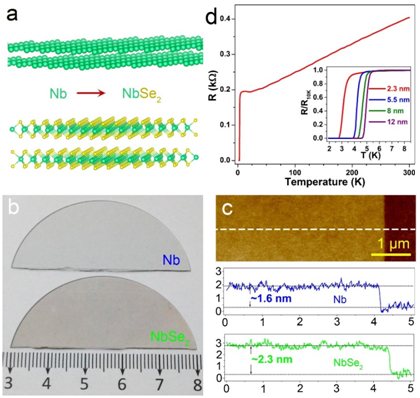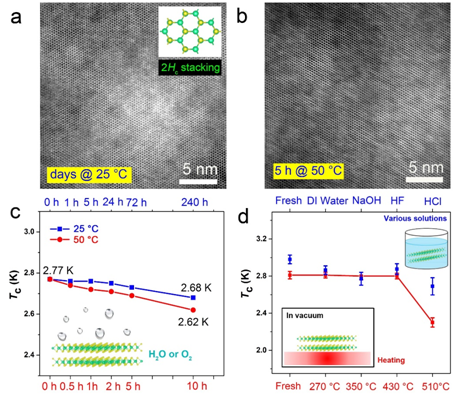On March 11th , Prof. Jiangwei Wang (School of Materials Science and Engineering, Zhejiang University) and Prof. Libo Gao (School of Physics, Nanjing University) published their cooperative research results, growth of environmentally stable transition metal selenide films, on Nature Materials. The researchers proposed a new two-step vapor deposition method, successfully prepared an environmentally stable superconducting selenide film, and combined with advanced electron microscopy techniques, revealed the important influence on instability of two-dimensional transition metal chalcogenides by lattice defects. This work has further developed the understanding of the stability of two-dimensional materials in the atmospheric environment, and is of great significance for the industrial application of two-dimensional materials.
Two-dimensional materials represented by graphene attracted researcher’s attention as their unique mechical, thermal, optical, electronic, magnetic and other physical characterizations. Two-dimensional transition metal chalcogenides, including transition metal sulfide (e.g. MoS2, WS2, ReS2), selenide(e.g. WSe2, NbSe2, TiSe2, InSe, FeSe, etc.), which is simple in crystal structures, easy to obtain, with various properties. They become optimal platform for flexible semiconductor, photoelectric, superconducting and spin-electronic materials. However, its instability in atmosphere environment brings a lot of trouble to devices manufacturing, limiting its industrial application.
To solve this problem, Prof. Gao of School of Physics, Nanjing University, by experimental observation and theoretical predictin, discovered that the instability of the samples in atmosphere environment origins from oxygen bonds and atomic vacancy in two-dimensional materials. On this basis, they reported new two-step vapor deposition method, which helps to prepare superconducting NbSe2 film with no oxygen bond and atom vacancy(Fig.1). The researchers used a series of harsh environmental treatments (including long-term placement in the atmosphere, baking in the atmosphere, various aqueous solutions, and annealing under high vacuum), and found that film prepared by the new method still maintains superconducting properties (Fig. 1d). A large number of atomic scale structural characterizations were observed by spherical aberration-corrected electron microscopy. The lattice structure of the NbSe2 film remained intact before and after the harsh conditions, and almost no vacancies were generated (Fig. 2). It was confirmed experimentally that the lattice defects were two-dimensional. An important influence on the instability of transition metal chalcogenides. Further analysis shows that most of the two-dimensional materials can exist stably in the atmospheric environment, in which the key point is regulation of lattice defects during the preparation process. The new two-step vapor deposition method minimizes the concentration of oxygen bonds and atomic vacancies, so the NbSe2 film is grown with extremely high environmental stability. Using the same method, the researchers also successfully prepared a TiSe2 film with high environmental stability. Therefore, this work not only develops the current understanding of the stability of two-dimensional materials in the atmospheric environment, but also plays an important role in simplifying the manufacturing process of two-dimensional material devices and further promoting their industrial applications.
Huihui Lin, PhD. candidate in School of Physics, Nanjing University, and Qi Zhu, PhD. Candidate in School of Materials, Zhejiang University are the co-first authors. Prof. Libo Gao and Prof. Jiangwei Wang are corresponding authors. This research was supported by State Key Laboratory of Solid State Microstructures in Nanjing University, State Key Laboratory of Silicon Materials in Zhejiang University, Central College Basic Research Fee, National Key Research and Development Program for Quantum Regulation of the Ministry of Science and Technology, National Natural Science Foundation of China, Youth Thousand Talents Program, Natural Science Foundation of Jiangsu Province and Nanjing University Supercomputing Center.
https://www.nature.com/articles/s41563-019-0321-8

Fig.1 (a) Structure change from Nb to NbSe2, (b)NbSe2 film prepared by PVD and CVD, (c)thickness changes of Nb and NbSe2 film in different methods, (d) NbSe2 temperature-dependent resistance curves with different thicknesses, its superconducting properties vary with thickness.

Fig. 2 (a,b)STEM images after several days in room temperature and heating to 50℃, respectively, in atmosphere, in which NbSe2 lattice structure remains completed, (c)Tc after exposed in atmosphere for different time (blue: room temperature, red:50℃), (d)Tc of NbSe2 which is soaked in different solutions (blue) and after vacuum annealing (red).



